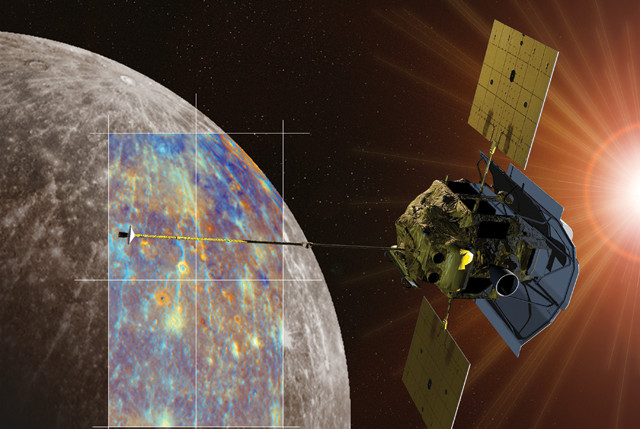
by Timothy Oleson Monday, August 24, 2015

Artist's impression of MESSENGER passing over Mercury's Hokusai Crater. Credit: NASA/Johns Hopkins University Applied Physics Laboratory/Carnegie Institution of Washington.
After 11 years in space and more than 4,100 laps around Mercury since entering orbit in 2011, NASA’s MESSENGER spacecraft was decommissioned in heroic fashion on April 30, slamming into the planet’s surface at more 14,000 kilometers per hour after it had run out of propellant. Fittingly, it gouged a 16-meter-wide crater of its own amid the myriad others it observed there.
Mariner 10 completed several flybys of Mercury in the mid-1970s, but prior to MESSENGER (short for MErcury Surface, Space ENvironment, GEochemistry and Ranging), relatively little was known about our solar system’s innermost planet. The spacecraft collected hundreds of thousands of images over its life, helping scientists stitch together a detailed global map of Mercury; it road-tested various technological innovations, including a ceramic cloth sunshade that kept it from roasting under the sun’s intense heat; and it returned reams of data that have contributed to numerous discoveries.
And the findings keep on coming. Days after its demise, in fact, researchers reported in Science that Mercury’s magnetic field has likely existed for at least 3.7 billion years. Mercury is the only planet in the inner solar system other than Earth that boasts a dynamo-driven global magnetic field today (although it’s only about 1 percent the strength of Earth’s), but exactly how long the field has existed is still unknown.
Catherine Johnson of the University of British Columbia in Vancouver, Canada, and colleagues analyzed low-altitude magnetic field measurements collected by MESSENGER beginning in April 2014 when its shrinking orbit took it within 200 kilometers of the surface. The team found evidence of so-called remanent magnetization in ancient rocks at Mercury’s surface, left behind when magnetic minerals in these rocks aligned with a global magnetic field while cooling and solidifying. Similar measurements taken by MESSENGER on earlier occasions had not revealed the magnetization in the rocks, perhaps because the spacecraft was too far from the planet’s surface to pick up the weak signals, the researchers suggested.
Because MESSENGER was in communication through its final days as it dropped closer and closer to Mercury’s surface, there are yet more data to analyze and additional findings are likely to come. Here is a brief recap of some of the spacecraft’s other notable contributions:
Supporting a two-decade-old hypothesis, MESSENGER data showed in 2012 that Mercury’s shadowed, polar craters likely hold abundant water ice and other frozen volatile materials.
A host of MESSENGER observations helped reveal details of Mercury’s peculiar core, which is proportionally much larger than Earth’s and appears to have a liquid layer sandwiched between solid outer and inner layers.
MESSENGER was one of several spacecraft temporarily repurposed to watch Comet ISON in late 2013, the first comet thought to originate in the distant Oort Cloud and be observed passing through the inner solar system.
Based on analyses of fault-related ridges and scarps identified in imagery from MESSENGER, scientists determined in 2014 that Mercury’s radius has contracted 5 to 7 kilometers over the last 4 billion years.
In 2011, the spacecraft was honored on a U.S. Postal Service stamp.
© 2008-2021. All rights reserved. Any copying, redistribution or retransmission of any of the contents of this service without the expressed written permission of the American Geosciences Institute is expressly prohibited. Click here for all copyright requests.